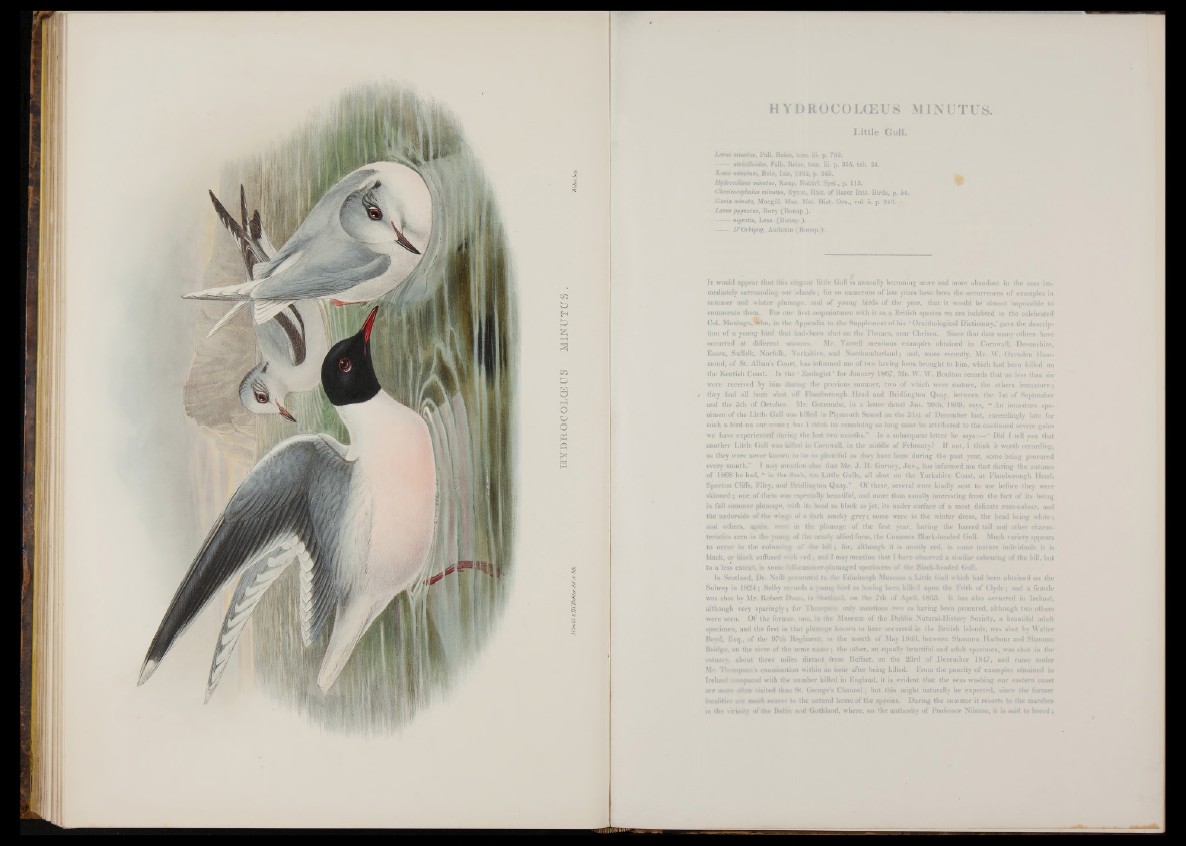
HYB BO COX Qi US MXNI7TUS .
HYDROCOLCEUS MINUTUS.
Little Gull.
Lartu minutus, Pall. Reise, tom. in. p. 702.
atrmttoiäes, Falk. Reise, tom. iii. p. 355, tab. 24.
Xema minvtum, Boie, Isis, 1822, p. 365.
Hydrocokeus minutus, Kaup, Natürl. Syst., p. 113. .
ühroicocephalus minutus, Eyion, Hist, of Rarer Brit. Birds, p. 64.
Gavio minuta, Macgill. Man. Nat. Hist. Orn., vol. ii. p. 242. fl
Larus pygmaus, Bory (Bonap.).
nigrotis, Less. (Bonap.).
- D'Orligny, Audouin (Bonap.).
It would appear that this degant little Gull is annually becoming more and more abundant in the seas immediately
surrounding our islands; for so numerous o f late years have befen the occurrences o f examples in
summer and winter plumage, and o f young birds o f the year, that it would be almost impossible to
enumerate them. For our first acquaintance with it as a British species we are indebted to the celebrated
Col. Montagu, ^ h o , in the Appendix to the Supplement of his ‘Ornithological Dictionary/gave the description
o f a young bird that had* been shot on the Thames, near Chelsea. Since that date many others have
occurred at different seasons. Mr. Yarrell mentions examples obtained in Cornwall, Devonshire,
Essex, Suffolk, Norfolk, Yorkshire, and Northumberland ; and, more recently, Mr. W. Oxenden Hammond,
o f St. Alban’s Court, has informed me o f two having been brought to him, which had been killed on
the Kentish Coast. In the * Zoologist’ for January 1867, Mr. W. W. Boulton records that no less than six-
were deceived by him during the previous summer, two of which were mature, the others immature;
they had all been shot off Flamborough Head and Bridlington Quay, between the 1st of September
and the 5th of October. Mr. Gatcombe, in a letter dated Jan. 20th, 1869, says, “ An immature specimen
o f the Little Gull was killed in Plymouth Sound on the 31st of December last, exceedingly late for
such a bird on our coast; but 1 think its remaining so long must be attributed to the continued severe gales
we have experienced during the last two months.” In a subsequent letter he says:— t: Did I tell you that
another Little Gull was killed in Cornwall, in the middle of February? If not, I think it worth recording,
as they were never known to be so plentiful as they have been during the past year, some being procured
every month.” I may mention also that Mr. J. H. Gurney, Jun., has informed me that during the autumn
o f 1868 he had, “ in the Sesh, ten Little Gulls, all shot on the Yorkshire Coast, at Flamborough Head,
Speetou Cliffs, Filey, and Bridlington Quay.” O f these, several were kindly sent to me before they were
skinned ; one of them was especially beautiful, and more than usually interesting from the fact o f its being
in full summer plumage, with if head as black as jet, its under surface o f a most delicate rose-colour, and
the underside o f the wings of a dark smoky grey; some were in the winter dress, the head being white;
and others, again, were in the plumage of the first year, having the barred tail and other characteristics
seen in the you of the nearly allied form, the Common Black-headed Gull. Much variety appears
to occur in the colouring o f the bill; for, although it is mostly red, in some mature individuals it is
black, or black suffused w iUi red and I may mention that I have observed a similar colouring o f the bill, but
to a less extent, in some sll-sii.uin; er-p'uimaged specimens of the Black-headed Gull.
In Scotland, Dr. Neill presented to the Edinburgh Museum a Little Gull which had been obtained on the
Solway in 1824; Selby records a young bird as having been killed upon the Frith o f Clyde; and a female
was shot by Mr. Robert Du mi, in Sheti.i»>4, on the 7tb o f April, 1853. It has also occurred in Irelaud,
although very sparingly; for Thompson only mentions two as having been procured, although two others
Were seen. Of the former, one, to the Museum o f the Dublin Natural-History Society, a beautiful adult
specimen, and the first in that plumage known to have occurred in the British Islands, was shot by Walter
Boyd, Esq., o f the 97th Regiment, in the month o f May 1840, between Shannon Harbour and Shannon
Bridge, on the river of the same name; the other, an equally beautiful and adult specimen, was shot in the
estuary, about three miles distant from Belfast, on the 23rd o f December 1847, and came under
Mr. Thompson's examination witfain an hour after being killed. From the paucity o f examples obtained in
Ireland compared with the number killed in England, it is evident that the seas washing our eastern coast
are more often visited than St. George’s Channel; but this might naturally be expected, since the former
localities are much nearer to the natural home o f the species. During the summer it resorts to the marshes
in the vicinity of the Baltic and Gothland, where, on the authority o f Professor Nilsson, it is said to breed;